Design and Optimization of Air Inlet in Cuttings Incubator
Abstract
1. Introduction
2. Methods
2.1. Incubator Model Description
2.2. CFD Model
2.2.1. Governing Equation
2.2.2. Thermostatic Plate and Substrate
2.2.3. LED Lamp
2.2.4. Porous Media
2.2.5. Respiratory Heat
2.3. Boundary Conditions
2.4. Grid Quality and Solver Settings
2.5. Parameter Optimization
3. Results
3.1. Model Validation
3.2. Design of Air Inlet
3.2.1. Single-Factor Numerical Fitting
3.2.2. Orthogonal Experiment and Multivariate Model Establishment
3.3. Optimization of Air Inlet
3.3.1. Optimization Results
3.3.2. Parameter Validation
4. Discussion
5. Conclusions
Author Contributions
Funding
Data Availability Statement
Acknowledgments
Conflicts of Interest
References
- Anderson, J.T.; Song, B. Plant Adaptation to Climate Change—Where Are We? J. Syst. Evol. 2020, 58, 533–545. [Google Scholar] [CrossRef]
- Wheeler, T.; Von Braun, J. Climate Change Impacts on Global Food Security. Science 2013, 341, 508–513. [Google Scholar] [CrossRef]
- Singh, D.; Kumar, A. Multivariate Screening Approach Indicated Adaptive Tolerance to Salt Stress in the Seedlings of an Agroforestry Tree, Eucalyptus Tereticornis Sm. Plant Cell Tiss. Org. 2021, 145, 545–560. [Google Scholar] [CrossRef]
- Wang, H.; Zhou, Z.; Yang, Z.; Cao, Y.; Zhang, C.; Cheng, C.; Zhou, Z.; Wang, F.; Hu, C.; Feng, X.; et al. Constraints on the high-quality development of Chinese fruit industry. China Fruits 2023. [Google Scholar] [CrossRef]
- Graamans, L.; Baeza, E.; Van Den Dobbelsteen, A.; Tsafaras, I.; Stanghellini, C. Plant Factories versus Greenhouses: Comparison of Resource Use Efficiency. Agric. Syst. 2018, 160, 31–43. [Google Scholar] [CrossRef]
- Bartzanas, T.; Boulard, T.; Kittas, C. Effect of Vent Arrangement on Windward Ventilation of a Tunnel Greenhouse. Biosyst. Eng. 2004, 88, 479–490. [Google Scholar] [CrossRef]
- Lee, I.-B.; Short, T.H. Two-Dimensional Numerical Simulation of Nutaral Ventilation in a MultI-Span Greenhouse. Trans. ASAE 2000, 43, 745–753. [Google Scholar] [CrossRef]
- Kitaya, Y.; Tsuruyama, J.; Shibuya, T.; Yoshida, M.; Kiyota, M. Effects of Air Current Speed on Gas Exchange in Plant Leaves and Plant Canopies. Adv. Space Res. 2003, 31, 177–182. [Google Scholar] [CrossRef]
- Roy, J.C.; Pouillard, J.B.; Boulard, T.; Fatnassi, H.; Grisey, A. Experimental and CFD Results on the CO2 Distribution in a Semi Closed Greenhouse. Acta Hortic. 2014, 1037, 993–1000. [Google Scholar] [CrossRef]
- Tamimi, E.; Kacira, M. Analysis of Climate Uniformity in a Naturally Ventilated Greenhouse Equipped with High Pressure Fogging System Using Computational Fluid Dynamics. Acta Hortic. 2013, 1008, 177–183. [Google Scholar] [CrossRef]
- Carotti, L.; Graamans, L.; Puksic, F.; Butturini, M.; Meinen, E.; Heuvelink, E.; Stanghellini, C. Plant Factories Are Heating Up: Hunting for the Best Combination of Light Intensity, Air Temperature and Root-Zone Temperature in Lettuce Production. Front. Plant Sci. 2021, 11, 592171. [Google Scholar] [CrossRef]
- Confalonieri, M.; Balestrazzi, A.; Bisoffi, S.; Carbonera, D. In Vitro Culture and Genetic Engineering of Populus Spp.: Synergy for Forest Tree Improvement. Plant Cell Tiss. Org. 2003, 72, 109–138. [Google Scholar] [CrossRef]
- Bournet, P.-E.; Boulard, T. Effect of Ventilator Configuration on the Distributed Climate of Greenhouses: A Review of Experimental and CFD Studies. Comput. Electron. Agric. 2010, 74, 195–217. [Google Scholar] [CrossRef]
- Bournet, P.-E.; Rojano, F. Advances of Computational Fluid Dynamics (CFD) Applications in Agricultural Building Modelling: Research, Applications and Challenges. Comput. Electron. Agric. 2022, 201, 107277. [Google Scholar] [CrossRef]
- Norton, T.; Sun, D.-W.; Grant, J.; Fallon, R.; Dodd, V. Applications of Computational Fluid Dynamics (CFD) in the Modelling and Design of Ventilation Systems in the Agricultural Industry: A Review. Bioresource Technol. 2007, 98, 2386–2414. [Google Scholar] [CrossRef]
- Majdoubi, H.; Boulard, T.; Fatnassi, H.; Bouirden, L. Airflow and Microclimate Patterns in a One-Hectare Canary Type Greenhouse: An Experimental and CFD Assisted Study. Agric. For. Metorol. 2009, 149, 1050–1062. [Google Scholar] [CrossRef]
- Villagrán, E.A.; Baeza Romero, E.J.; Bojacá, C.R. Transient CFD Analysis of the Natural Ventilation of Three Types of Greenhouses Used for Agricultural Production in a Tropical Mountain Climate. Biosyst. Eng. 2019, 188, 288–304. [Google Scholar] [CrossRef]
- He, K.; Chen, D.; Sun, L.; Huang, Z.; Liu, Z. Effects of Vent Configuration and Span Number on Greenhouse Microclimate under Summer Conditions in Eastern China. Int. J. Vent. 2015, 13, 381–396. [Google Scholar] [CrossRef]
- Boulard, T.; Roy, J.-C.; Pouillard, J.-B.; Fatnassi, H.; Grisey, A. Modelling of Micrometeorology, Canopy Transpiration and Photosynthesis in a Closed Greenhouse Using Computational Fluid Dynamics. Biosyst. Eng. 2017, 158, 110–133. [Google Scholar] [CrossRef]
- Saberian, A.; Sajadiye, S.M. The Effect of Dynamic Solar Heat Load on the Greenhouse Microclimate Using CFD Simulation. Renew. Energ. 2019, 138, 722–737. [Google Scholar] [CrossRef]
- Boulard, T.; Wang, S. Experimental and Numerical Studies on the Heterogeneity of Crop Transpiration in a Plastic Tunnel. Comput. Electron. Agric. 2002, 34, 173–190. [Google Scholar] [CrossRef]
- Hui, F.; Kun, L.; Wu, G.; Cheng, R.; Yi, Z.; Yang, Q. A CFD Analysis on Improving Lettuce Canopy Airflow Distribution in a Plant Factory Considering the Crop Resistance and LEDs Heat Dissipation. Biosyst. Eng. 2020, 200, 1–12. [Google Scholar] [CrossRef]
- Yu, H.; Yu, H.; Zhang, B.; Chen, M.; Liu, Y.; Sui, Y. Quantitative Perturbation Analysis of Plant Factory LED Heat Dissipation on Crop Microclimate. Horticulturae 2023, 9, 660. [Google Scholar] [CrossRef]
- Dhiman, M.; Sethi, V.P.; Singh, B.; Sharma, A. CFD Analysis of Greenhouse Heating Using Flue Gas and Hot Water Heat Sink Pipe Networks. Comput. Electron. Agric. 2019, 163, 104–853. [Google Scholar] [CrossRef]
- Mostafavi, S.A.; Rezaei, A. Energy Consumption in Greenhouses and Selection of an Optimized Heating System with Minimum Energy Consumption. Heat Transf. Asian Res. 2019, 48, 3257–3277. [Google Scholar] [CrossRef]
- Li, H.; Rong, L.; Zong, C.; Zhang, G. Assessing Response Surface Methodology for Modelling Air Distribution in an Experimental Pig Room to Improve Air Inlet Design Based on Computational Fluid Dynamics. Comput. Electron. Agric. 2017, 141, 292–301. [Google Scholar] [CrossRef]
- Shen, X.; Zhang, G.; Bjerg, B. Investigation of Response Surface Methodology for Modelling Ventilation Rate of a Naturally Ventilated Building. Build. Environ. 2012, 54, 174–185. [Google Scholar] [CrossRef]
- Hadiyat, M.A.; Sopha, B.M.; Wibowo, B.S. Response Surface Methodology Using Observational Data: A Systematic Literature Review. Appl. Sci. 2022, 12, 10663. [Google Scholar] [CrossRef]
- De Oliveira, L.G.; De Paiva, A.P.; Balestrassi, P.P.; Ferreira, J.R.; Da Costa, S.C.; Da Silva Campos, P.H. Response Surface Methodology for Advanced Manufacturing Technology Optimization: Theoretical Fundamentals, Practical Guidelines, and Survey Literature Review. Int. J. Adv. Manuf. Technol. 2019, 104, 1785–1837. [Google Scholar] [CrossRef]
- Ng, K.C.; Kadirgama, K.; Ng, E.Y.K. Response Surface Models for CFD Predictions of Air Diffusion Performance Index in a Displacement Ventilated Office. Energy Build. 2008, 40, 774–781. [Google Scholar] [CrossRef]
- Shen, X.; Zhang, G.; Wu, W.; Bjerg, B. Model-Based Control of Natural Ventilation in Dairy Buildings. Comput. Electron. Agric. 2013, 94, 47–57. [Google Scholar] [CrossRef]
- Norton, T.; Grant, J.; Fallon, R.; Sun, D.-W. Optimising the Ventilation Configuration of Naturally Ventilated Livestock Buildings for Improved Indoor Environmental Homogeneity. Build. Environ. 2010, 45, 983–995. [Google Scholar] [CrossRef]
- Li, K.; Yan, S.; Zhong, Y.; Pan, W.; Zhao, G. Multi-Objective Optimization of the Fiber-Reinforced Composite Injection Molding Process Using Taguchi Method, RSM, and NSGA-II. Simul. Model. Pract. Theory 2019, 91, 69–82. [Google Scholar] [CrossRef]
- Fu, J.; Yuan, H.; Zhang, D.; Chen, Z.; Ren, L. Multi-Objective Optimization of Process Parameters of Longitudinal Axial Threshing Cylinder for Frozen Corn Using RSM and NSGA-II. Appl. Sci. 2020, 10, 1646. [Google Scholar] [CrossRef]
- Xie, Y.; Hu, P.; Zhu, N.; Lei, F.; Xing, L.; Xu, L. Collaborative Optimization of Ground Source Heat Pump-Radiant Ceiling Air Conditioning System Based on Response Surface Method and NSGA-II. Renew. Energy 2020, 147, 249–264. [Google Scholar] [CrossRef]
- Mi, Z.; Yang, X.; Mao, L.; Qian, J.; Guo, P. Structure and Control System Design of Apple Shoot Cutting Incubator. J. Agric. Mech. Res. 2022, 44, 135–139, 169. [Google Scholar] [CrossRef]
- Patankar, S.V. Numerical Heat Transfer and Fluid Flow, 1st ed.; CRC Press: Boca Raton, FL, USA, 2018; ISBN 978-1-315-27513-0. [Google Scholar]
- Awbi, H.B. Ventilation and Air Distribution Systems in Buildings. Front. Mech. Eng. 2015, 1, 126310. [Google Scholar] [CrossRef]
- Zhang, Y.; Kacira, M. Analysis of Climate Uniformity in Indoor Plant Factory System with Computational Fluid Dynamics (CFD). Biosyst. Eng. 2022, 220, 73–86. [Google Scholar] [CrossRef]
- Tong, B.; Kool, D.; Heitman, J.L.; Sauer, T.J.; Gao, Z.; Horton, R. Thermal Property Values of a Central Iowa Soil as Functions of Soil Water Content and Bulk Density or of Soil Air Content. Eur. J. Soil Sci. 2020, 71, 169–178. [Google Scholar] [CrossRef]
- Zhu, J.; Zhang, X.; Xie, J.; Han, K.; Ma, N.; Mao, E.; Li, L. Prediction models for the effective thermal conductivity of cultivation substrates in solar greenhouses. Trans. Chin. Soc. Agric. Eng. 2021, 37, 199–207. [Google Scholar] [CrossRef]
- Nelson, J.A.; Bugbee, B. Supplemental Greenhouse Lighting: Return on Investment for LED and HPS Fixtures, 1st ed.; Controlled Environments: Suite A Brea, CA, USA, 2013; Volume 7. [Google Scholar]
- Boulard, T.; Kittas, C.; Roy, J.C.; Wang, S. REVIEW PAPER: Convective and Ventilation Transfers in Greenhouses, Part 2: Determination of the Distributed Greenhouse Climate. Biosyst. Eng. 2002, 83, 129–147. [Google Scholar] [CrossRef]
- Nield, D.A.; Bejan, A. Convection in Porous Media, 4th ed.; Springer International Publishing: Cham, Switzerland, 2017; ISBN 978-3-319-49561-3. [Google Scholar]
- Molina-Aiz, F.D.; Valera, D.L.; Álvarez, A.J.; Madueño, A. A Wind Tunnel Study of Airflow through Horticultural Crops: Determination of the Drag Coefficient. Biosyst. Eng. 2006, 93, 447–457. [Google Scholar] [CrossRef]
- Song, Y.; Vorsa, N.; Yam, K.L. Modeling Respiration–Transpiration in a Modified Atmosphere Packaging System Containing Blueberry. J. Food Eng. 2002, 53, 103–109. [Google Scholar] [CrossRef]
- Duan, H.; Wang, Z.; Hu, C. Development of a Simple Model Based on Chemical Kinetics Parameters for Predicting Respiration Rate of Carambola Fruit. Int. J. Food Sci. Technol. 2009, 44, 2153–2160. [Google Scholar] [CrossRef]
- Zhang, Y.; Kacira, M.; An, L. A CFD Study on Improving Air Flow Uniformity in Indoor Plant Factory System. Biosyst. Eng. 2016, 147, 193–205. [Google Scholar] [CrossRef]
- Askari-Khorasgani, O.; Pessarakli, M. Shifting Saffron (Crocus sativus L.) Culture from Traditional Farmland to Controlled Environment (Greenhouse) Condition to Avoid the Negative Impact of Climate Changes and Increase Its Productivity. J. Plant Nutr. 2019, 42, 2642–2665. [Google Scholar] [CrossRef]
- Lan, Y.-C.; Tam, V.W.; Xing, W.; Datt, R.; Chan, Z. Life Cycle Environmental Impacts of Cut Flowers: A Review. J. Clean. Prod. 2022, 369, 133415. [Google Scholar] [CrossRef]
- Zakurin, A.O.; Shchennikova, A.V.; Kamionskaya, A.M. Artificial-Light Culture in Protected Ground Plant Growing: Photosynthesis, Photomorphogenesis, and Prospects of LED Application. Russ. J. Plant. Physiol. 2020, 67, 413–424. [Google Scholar] [CrossRef]
- Ahmed, H.A.; Yu-xin, T.; Qichang, Y. Lettuce Plant Growth and Tipburn Occurrence as Affected by Airflow Using a Multi-Fan System in a Plant Factory with Artificial Light. J. Therm. Biol. 2020, 88, 102496. [Google Scholar] [CrossRef]
- Nurmalisa, M.; Tokairin, T.; Kumazaki, T.; Takayama, K.; Inoue, T.; Nurmalisa, M.; Tokairin, T.; Kumazaki, T.; Takayama, K.; Inoue, T. CO2 Distribution under CO2 Enrichment Using Computational Fluid Dynamics Considering Photosynthesis in a Tomato Greenhouse. Appl. Sci. 2022, 12, 7756. [Google Scholar] [CrossRef]
- Haibo, Y.; Lei, Z.; Haiye, Y.; Yucheng, L.; Chunhui, L.; Yuanyuan, S. Sustainable Development Optimization of a Plant Factory for Reducing Tip Burn Disease. Sustainability 2023, 15, 5607. [Google Scholar] [CrossRef]
- Shibuya, T.; Tsukuda, S.; Tokuda, A.; Shiozaki, S.; Endo, R.; Kitaya, Y. Effects of Warming Basal Ends of Carolina Poplar (Populus × Canadensis Moench.) Softwood Cuttings at Controlled Low-Air-Temperature on Their Root Growth and Leaf Damage after Planting. J. For. Res. 2013, 18, 279–284. [Google Scholar] [CrossRef]
- Shibuya, T.; Tokuda, A.; Terakura, R.; Shimizu-Maruo, K.; Sugiwaki, H.; Kitaya, Y.; Kiyota, M. Short-Term Bottom-Heat Treatment during Low-Air-Temperature Storage Improves Rooting in Squash (Cucurbita moschata Duch.) Cuttings Used for Rootstock of Cucumber (Cucumis sativus L.). J. Jpn. Soc. Hortic. Sci. 2007, 76, 139–143. [Google Scholar] [CrossRef][Green Version]
- Ameen, M.; Zhang, Z.; Wang, X.; Yaseen, M.; Umair, M.; Noor, R.S.; Lu, W.; Yousaf, K.; Ullah, F.; Memon, M.S. An Investigation of a Root Zone Heating System and Its Effects on the Morphology of Winter-Grown Green Peppers. Energies 2019, 12, 933. [Google Scholar] [CrossRef]
- Pramuk, L.A.; Runkle, E.S. Photosynthetic Daily Light Integral During the Seedling Stage Influences Subsequent Growth and Flowering of Celosia, Impatiens, Salvia, Tagetes, and Viola. HortScience 2005, 40, 1336–1339. [Google Scholar] [CrossRef]
- Gibson, K. Environmental Accounting: Some Australian Developments. Soc. Environ. Account. J. 2001, 21, 4–7. [Google Scholar] [CrossRef]
- Wilkerson, E.G.; Gates, R.S.; Zolnier, S.; Kester, S.T.; Geneve, R.L. Predicting Rooting Stages in Poinsettia Cuttings Using Root Zone Temperature-Based Models. J. Am. Soc. Hortic. Sci. 2005, 130, 302–307. [Google Scholar] [CrossRef]
- Kohler, A.E.; Lopez, R.G. Propagation of Herbaceous Unrooted Cuttings of Cold-Tolerant Species under Reduced Air Temperature and Root-Zone Heating. Sci. Hortic. 2021, 290, 110485. [Google Scholar] [CrossRef]
- Muramatsu, Y.; Kubota, S. The Development of a Root-Zone Environmental Control System (N.RECS) and Its Application to Flower Production. Hortic. J. 2021, 90, 239–246. [Google Scholar] [CrossRef]
- Olberg, M.W.; Lopez, R.G. Bench-Top Root-Zone Heating Hastens Development of Petunia under a Lower Air Temperature. HortScience 2017, 52, 54–59. [Google Scholar] [CrossRef]
- Wang, J.; Chen, J.; Han, D.; Lin, Z.; Huang, C.; Zheng, S.; Zhong, F.; Hou, M. Design and simulation of the circulating air supply system for a ventilated wall-type plant factory based on the principle of uniform flow plate. Trans. CSAE 2023, 39, 213–221. [Google Scholar] [CrossRef]
- Zhang, J.; Jiao, X.; Du, Q.; Song, X.; Ding, J.; Li, J. Effects of Vapor Pressure Deficit and Potassium Supply on Root Morphology, Potassium Uptake, and Biomass Allocation of Tomato Seedlings. J Plant Growth Regul. 2021, 40, 509–518. [Google Scholar] [CrossRef]
- Yuan, W.; Zheng, Y.; Piao, S.; Ciais, P.; Lombardozzi, D.; Wang, Y.; Ryu, Y.; Chen, G.; Dong, W.; Hu, Z.; et al. Increased Atmospheric Vapor Pressure Deficit Reduces Global Vegetation Growth. Sci. Adv. 2019, 5, eaax1396. [Google Scholar] [CrossRef] [PubMed]
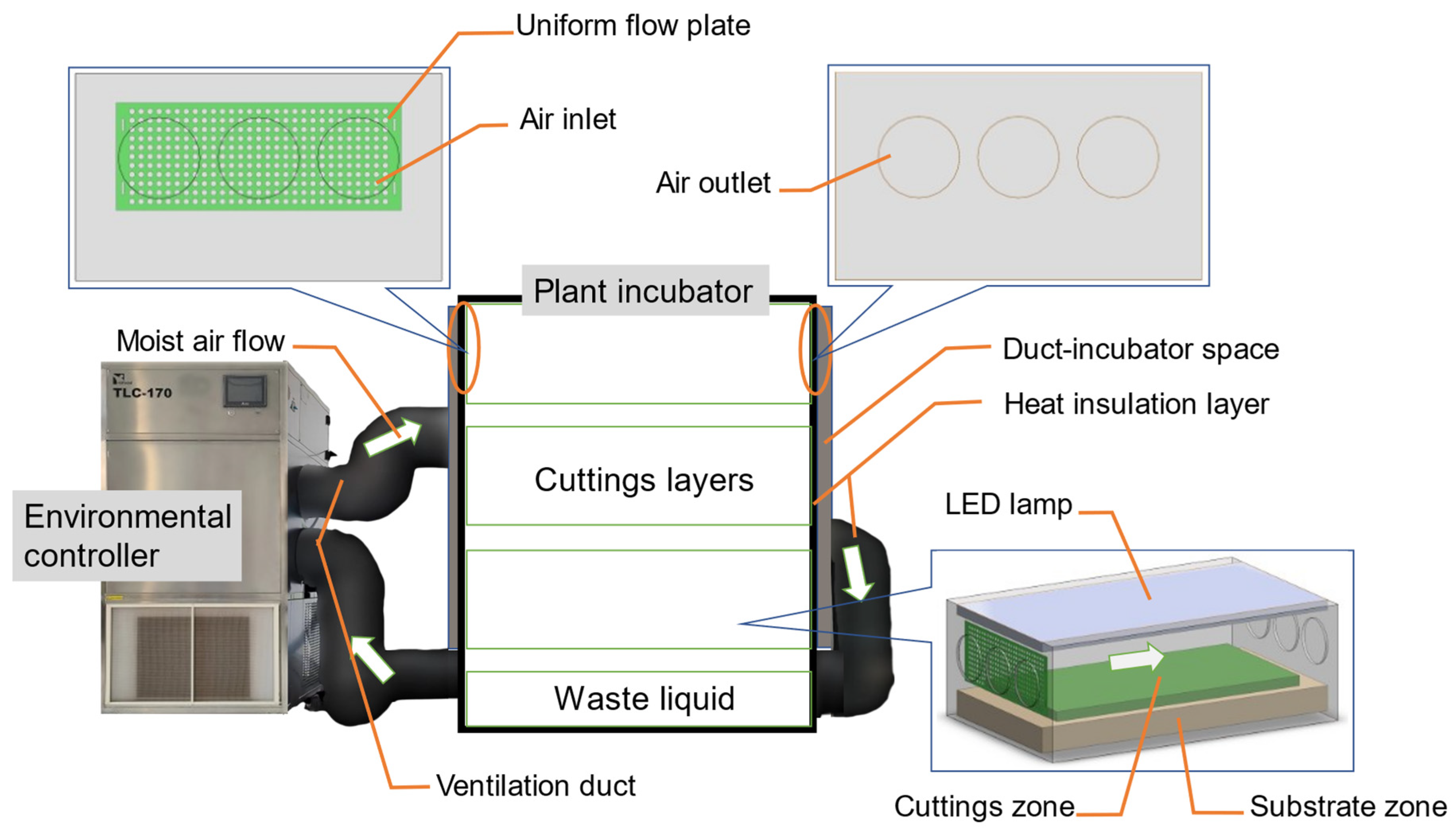
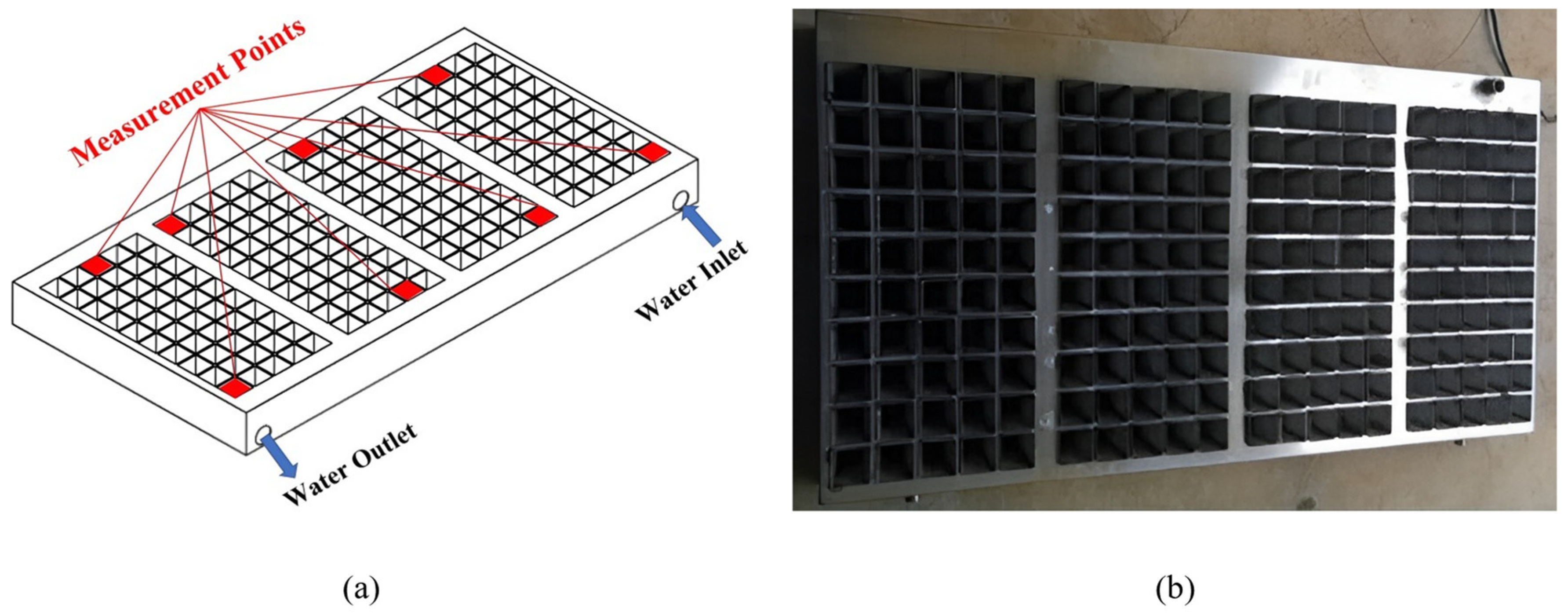
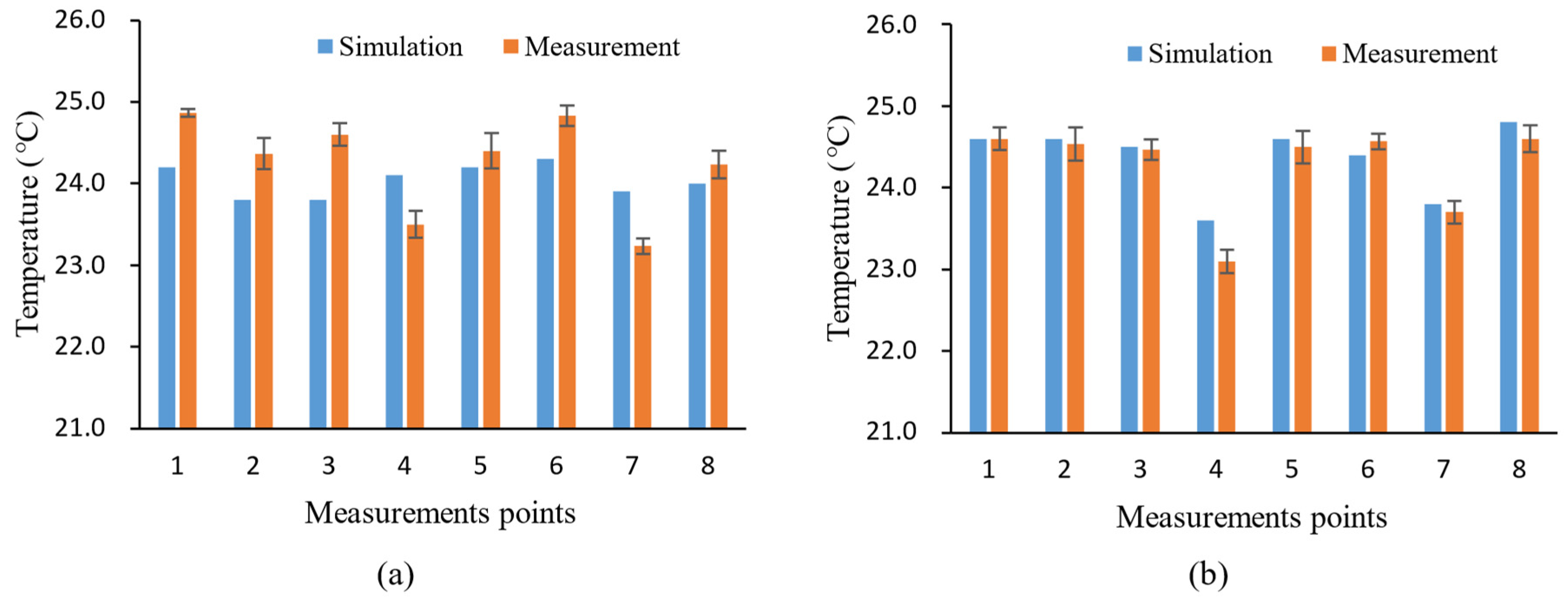
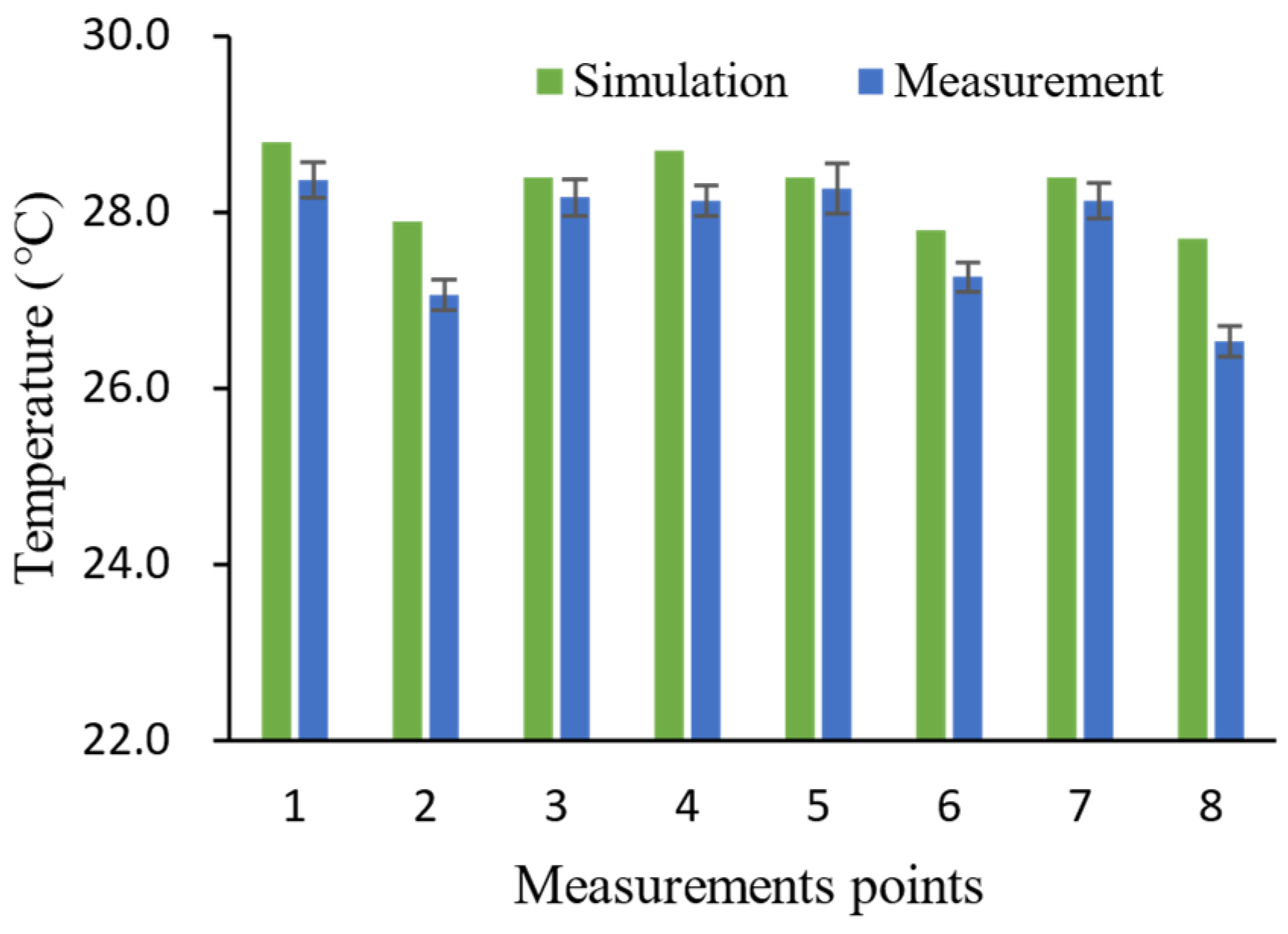


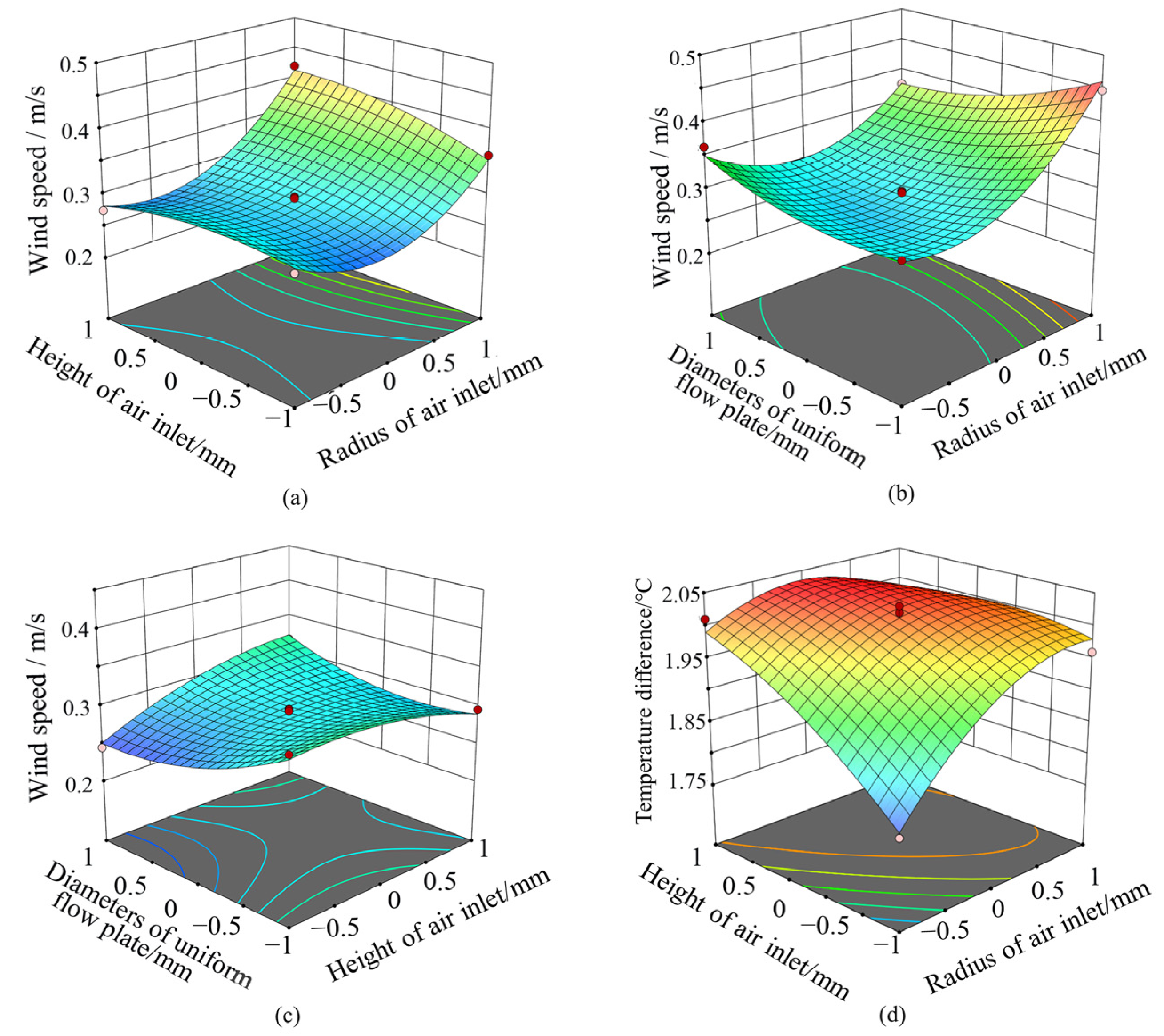
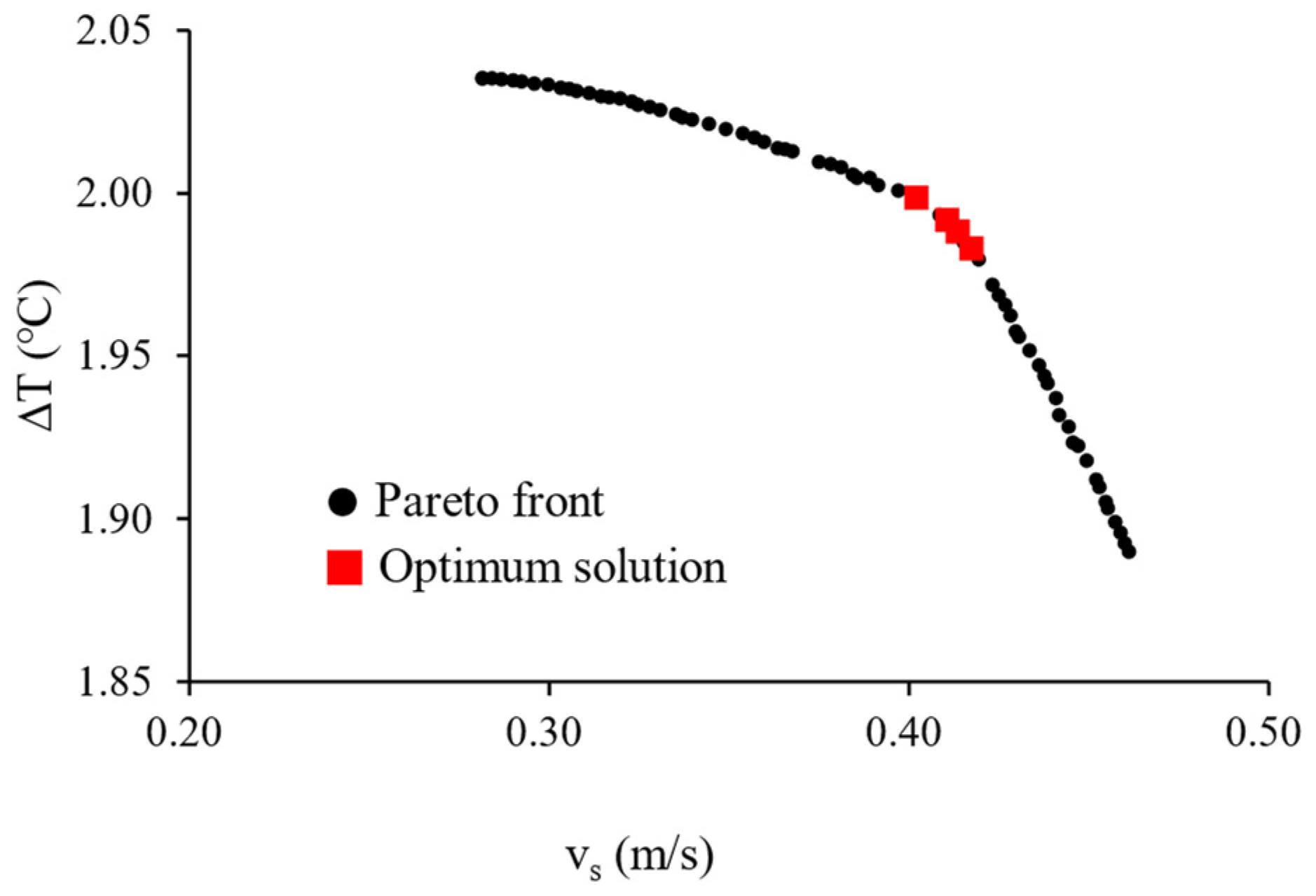
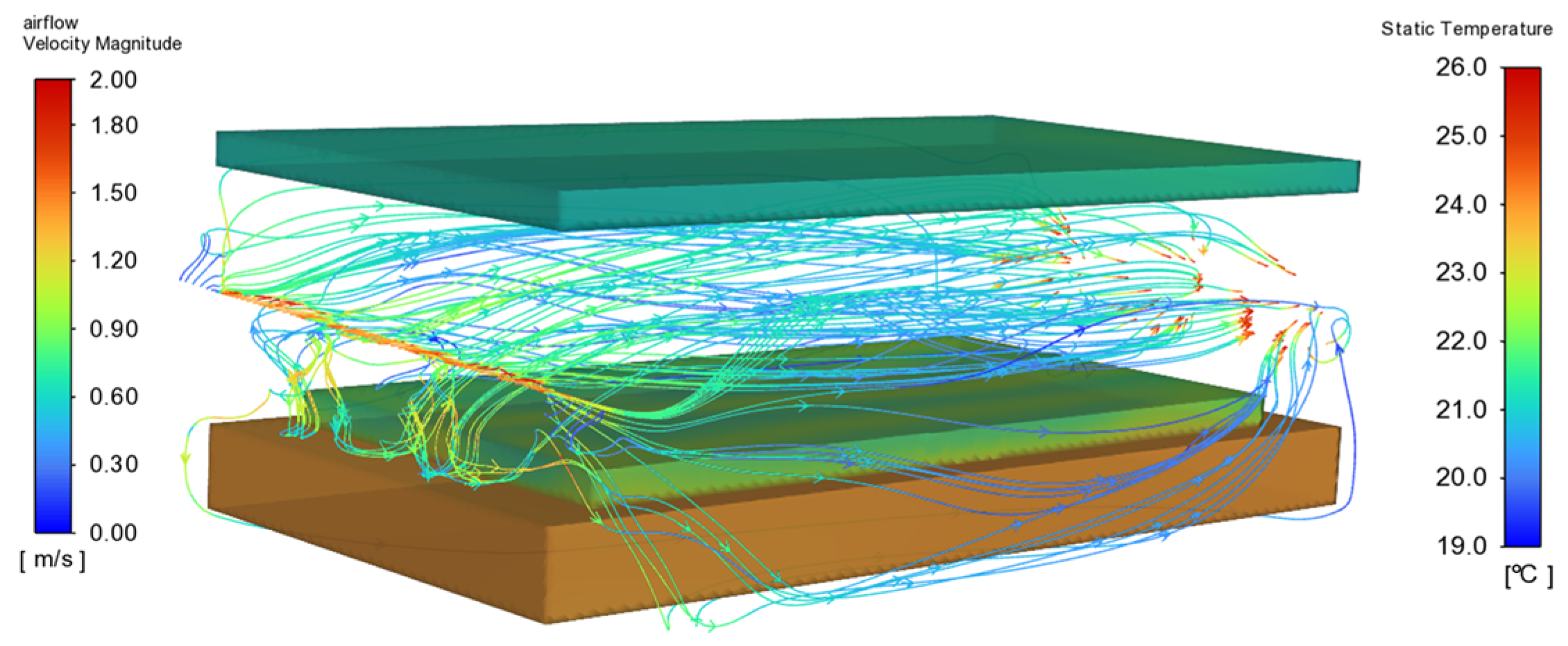

| Parameter | Substrate | Cuttings | Air | Glass | Plastic | Aluminum |
|---|---|---|---|---|---|---|
| Density | 550 | 900 | 1.225 | 2500 | 1430 | 2719 |
| kg/m3 | ||||||
| Specific heat capacity | 1000 | 2800 | 1005 | 830 | 1150 | 871 |
| J/(kg·K) | ||||||
| Thermal conductivity | 0.49 | 0.5 | 2.53 × 10−3 | 1.3 | 0.52 | 202.4 |
| W/(m·K) |
| Fluid: Mixture (air and water vapor) | |
| Inlet airflow temperature: 21 °C Inlet humidity ratio: 0.0121 g m−3 Gravitational acceleration: 9.81 m s−2 | |
| Model | Property |
| Energy model | Activated |
| Viscous model | Standard k-epsilon model |
| Cuttings | Porous zone (viscous resistance was 100 m−2, inertial resistance was 0.02 m−1, and fluid porosity was 0.97) |
| Species transport model | Activated with mixture of materials (air and water vapor) |
| Parameters | Boundary conditions |
| Inlets | Velocity inlet (1.5 m s−1) |
| Wall | Insulation |
| Lights surface | Material: glass; T was derived from the equation |
| Substrate surface | Material: substrate; T was derived from the equation |
| Group Number | Number of Air Inlets | Ra (mm) | Ha (mm) | Dp (mm) |
|---|---|---|---|---|
| 1 to 3 | 1 to 3 | 70 | 275 | - |
| 4 to 10 | 3 | 40 to 100 | 275 | 15 |
| 11 to 17 | 3 | 70 | 230 to 320 | 15 |
| 18 to 24 | 3 | 70 | 275 | 12 to 18 |
| Level | Factor | ||
|---|---|---|---|
| A: Ra (mm) | B: Ha (mm) | C: Dp (mm) | |
| −1 | 70 | 170 | 12 |
| 0 | 80 | 185 | 14 |
| 1 | 90 | 200 | 16 |
| Y1 (vs) | Y2 (∆t) | |||
|---|---|---|---|---|
| F-Value | p-Value | F-Value | p-Value | |
| Model | 42.39 | <0.0001 | 28.51 | 0.0001 |
| A | 139.53 | <0.0001 | 37.29 | 0.0005 |
| B | 6.54 | 0.0377 | 46.88 | 0.0002 |
| C | 6.05 | 0.0435 | 0.5479 | 0.4832 |
| AB | 13.07 | 0.0086 | 27.4 | 0.0012 |
| AC | 34.32 | 0.0006 | 8.29 | 0.0237 |
| BC | 22.66 | 0.0021 | 0.6164 | 0.4581 |
| A2 | 134.85 | <0.0001 | 33.02 | 0.0007 |
| B2 | 8.67 | 0.0216 | 6.37 | 0.0396 |
| C2 | 14.93 | 0.0062 | 85.32 | <0.0001 |
| Lack-of-Fit | 6.56 | 0.0504 | 3.68 | 0.1204 |
| Average Temperature at the Top of the Cuttings | Average Temperature at the Base of the Cuttings | Average Temperature of the Substrate Surface | |
|---|---|---|---|
| Simulation | 21.1 °C | 24.0 °C | 23.0 °C |
| Measurement | 21.2 °C | 24.2 °C | 23.1 °C |
| MRE | 0.0207 | 0.0219 | 0.0158 |
| RMSE | 0.5624 | 0.5657 | 0.4984 |
Disclaimer/Publisher’s Note: The statements, opinions and data contained in all publications are solely those of the individual author(s) and contributor(s) and not of MDPI and/or the editor(s). MDPI and/or the editor(s) disclaim responsibility for any injury to people or property resulting from any ideas, methods, instructions or products referred to in the content. |
© 2024 by the authors. Licensee MDPI, Basel, Switzerland. This article is an open access article distributed under the terms and conditions of the Creative Commons Attribution (CC BY) license (https://creativecommons.org/licenses/by/4.0/).
Share and Cite
Gu, H.; Qian, J.; Li, S.; Jiang, Z.; Wang, X.; Li, J.; Yang, X. Design and Optimization of Air Inlet in Cuttings Incubator. Agronomy 2024, 14, 871. https://doi.org/10.3390/agronomy14040871
Gu H, Qian J, Li S, Jiang Z, Wang X, Li J, Yang X. Design and Optimization of Air Inlet in Cuttings Incubator. Agronomy. 2024; 14(4):871. https://doi.org/10.3390/agronomy14040871
Chicago/Turabian StyleGu, Haoyuan, Ji Qian, Shaobo Li, Zunhao Jiang, Xu Wang, Jianping Li, and Xin Yang. 2024. "Design and Optimization of Air Inlet in Cuttings Incubator" Agronomy 14, no. 4: 871. https://doi.org/10.3390/agronomy14040871
APA StyleGu, H., Qian, J., Li, S., Jiang, Z., Wang, X., Li, J., & Yang, X. (2024). Design and Optimization of Air Inlet in Cuttings Incubator. Agronomy, 14(4), 871. https://doi.org/10.3390/agronomy14040871






